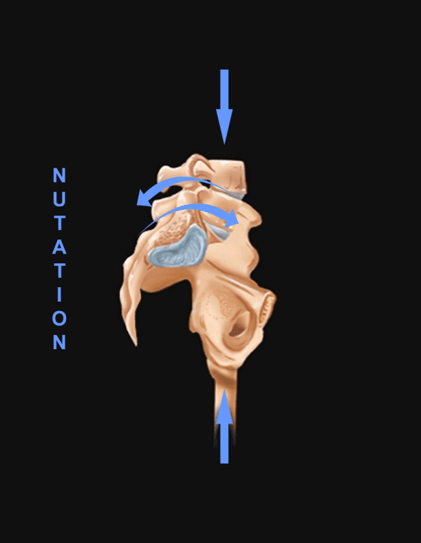
It is well established that bending, lifting, and twisting are the movements that cause most back pain. Biomechanically, these actions put more stress on the sacroiliac joints than on the lumbar discs. So, when we consider biomechanical approaches to back, hip, or leg pain, we should first look at the sacroiliac joint because of how forces are transferred through our structure.
When force (weight) is transmitted downward through the spine or upward through the legs, a spring like action takes place. The sacrum rotates forward and downward and the ilium rotates backward and downward. In this action, called nutation, these movements wind up the sacroiliac ligaments, like a compressing spring. Once the energy is absorbed and the end of range of motion is reached, the body reacts by going into counternutation, and all the above actions are reversed. Through this mechanism, the sacroiliac ligaments can be seen as the central spring in shock absorption.
When the force is greater than the ligaments can withstand, the restraining ligaments will tear, and the joint goes past its normal end point in nutation. Failure of this mechanism to maintain ligamentous integrity is the core injury of the sacroiliac joint, which I have named the Sacroiliac Nutation Syndrome. The central spring in the shock absorber system is damaged, and the normal mechanism of force transference becomes compromised. The sacroiliac joint injury is mostly caused by the following actions.
The Mechanisms of Sacroiliac Joint Injury
1. A fall onto the buttocks.
2. A motor vehicle accident where the driver brakes hard during impact, or there is a broadside impact that causes twisting.
3. Stepping into a hole, missing a step, or landing hard on one’s feet.
4. Repetitive rotation, especially when striking an object, such as in golf, batting, throwing, or soccer, especially when combined with an axial load such as in bowling, ballet, or skating.
5. Bending, lifting, or twisting.
6. The cumulative effect of nutation pattern injuries in the sacroiliac or other joints.
The body may be seen as one interconnecting shock absorption system, in which each joint forms a link in our kinetic chain. Almost every movement we make, whether it be bending, lifting or twisting, picking something up, or even walking, transfers force through our core. When any joint is injured, the ligaments cause the muscles to alter their movement pattern to avoid transferring force through the damaged portion of the ligaments. When the sacroiliac joint is injured, the effect transfers throughout the structure and eventually can affect almost any joint in the body, depending on use and postural stress placed on the joint. So, a runner may experience more foot, knee, or hip pain. A massage therapist may experience more shoulder and arm pain. A golfer may experience more low back and hip pain, etc.
Once understood, the sacroiliac joint may be seen as the main cause of most musculoskeletal injuries, even lumbar disc herniation.
For more information on the Mechanisms of Injury, please visit: Mechanisms of Injury
Did this article interest you? Read even more articles like this one by going to our main Blog Page. Do you have any suggestions for topics or something you would like to have Dr. Serola elaborate on? Contact us anytime or leave us a comment below

